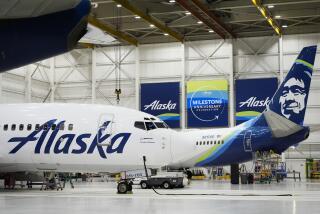Level With Us, FAA
- Share via
Critics of the Federal Aviation Administration, who tend to congregate after airplane crashes, have the advantage of 20-20 hindsight. That doesn’t, however, mean their criticisms should be dismissed.
In 1996, after a cargo hold fire led to the crash of a ValuJet airliner in Florida, officials of the National Transportation Safety Board said the FAA should have required airlines to install fire detectors in cargo holds. And now, after the discovery that a faulty horizontal stabilizer may have contributed to the crash of an Alaska Airlines MD-83 jet off the California coast a month ago, FAA critics are saying the agency should have required all airlines to inspect the stabilizers after mechanics found corrosion in them in 1998.
Some of this is unfair. The hard fact is that it would be impractical for the FAA to ground entire fleets and require complicated, take-it-apart inspections every time a mechanic spots a potential airworthiness problem.
Still, FAA officials have failed to level with the public about how they make difficult decisions. Their recent insistence that “we do not allow safety to be compromised under any circumstances” slights the truth, which is that the agency is each day forced to make trade-offs between safety and cost, both in the design of airplanes and their maintenance.
U.S. commercial airlines remain one of the safest forms of travel. But FAA officials need to do more to explain to the public their progress at minimizing known safety dangers that are unrelated to the Alaska Airlines crash, which is still under study. For instance, Vernon Grose, an aviation safety consultant and former member of the National Transportation Safety Board, points out that more than 2,000 jets that are at least 20 years old are flying in the United States and says the FAA isn’t doing enough to address “the most serious issue in aviation today”: the cracked, chafed wiring insulation in some planes that could cause electrical shorts or arcing and a fire.
The FAA has a difficult job, but that should not absolve the agency from its duty to adequately explain the rationale behind its all-important systems for risk assessment.
More to Read
Inside the business of entertainment
The Wide Shot brings you news, analysis and insights on everything from streaming wars to production — and what it all means for the future.
You may occasionally receive promotional content from the Los Angeles Times.










